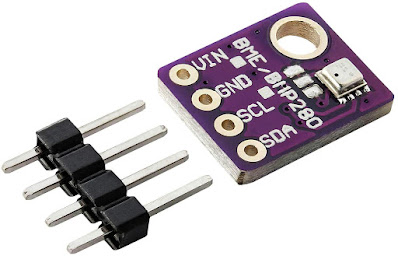BME280 as an altimeter
The BME280 is a useful critter which can accurately measure temperature, humidity and air pressure. It's a little more expensive than some of it's cousins (e.g. the BMP280), but packs a lot of punch into a tiny I2C driven module.
I have used the module before for tracking all three measurements (in the long running "hot house" project), but I was asked if I could make an altimeter for a school science project. Challenge accepted! Using the well known science principle that air pressure drops with altitude, I was able to adapt the code that Adafruit provides and put together a cute little project box with the required outcome.
/*************************************************************************** Altimeter based on http://www.adafruit.com/products/2650 OneCircuit Monday 12 October 19:27:44 AEDT 2020 ***************************************************************************/ #include <Wire.h> #include <SPI.h> #include <TM1637Display.h> #include <Adafruit_Sensor.h> #include <Adafruit_BME280.h> #include <SimpleRotary.h> #define CLK 2 #define DIO 3 float SEALEVELPRESSURE_HPA = 1000; float SEALEVELPRESSURE_HPA_PREC = 0; volatile byte pushed = 0; volatile byte whichway = 0; unsigned long delayTime = 500; SimpleRotary rotary(6, 5, 7); TM1637Display display(CLK, DIO); Adafruit_BME280 bme; void printValues() { float alt = bme.readAltitude(SEALEVELPRESSURE_HPA); display.setBrightness(0x0f); display.showNumberDec(alt); } void setup() { rotary.setTrigger(HIGH); rotary.setDebounceDelay(5); rotary.setErrorDelay(250); unsigned status; status = bme.begin(); if (!status) { while (1); } } void loop() { pushed = rotary.push(); if (pushed == 1) { pushed = 0; while (pushed == 0) { display.setBrightness(0x0f); display.showNumberDec(SEALEVELPRESSURE_HPA); pushed = rotary.push(); whichway = rotary.rotate(); if (whichway == 1) { SEALEVELPRESSURE_HPA++; } if (whichway == 2) { SEALEVELPRESSURE_HPA--; } } pushed = 0; while (pushed == 0) { display.setBrightness(0x0f); display.showNumberDec(SEALEVELPRESSURE_HPA_PREC); pushed = rotary.push(); whichway = rotary.rotate(); if ((whichway == 1) && (SEALEVELPRESSURE_HPA_PREC < 9)) { SEALEVELPRESSURE_HPA_PREC++; } if ((whichway == 2) && (SEALEVELPRESSURE_HPA_PREC > 0)) { SEALEVELPRESSURE_HPA_PREC--; } } SEALEVELPRESSURE_HPA = SEALEVELPRESSURE_HPA + SEALEVELPRESSURE_HPA_PREC / 10; } printValues(); delay(delayTime); }
/*************************************************************************** Sketch uses 12144 bytes (39%) of program storage space.Maximum is 30720 bytes. Global variables use 534 bytes (26%) of dynamic memory,leaving 1514 bytes for local variables. Maximum is 2048 bytes. ***************************************************************************/
Packaged up in a box with a Nano doing the grunt work the project looks like a bit of dog's breakfast, but it actually works well as intended. If I had the time I'd look into modifying the code a bit to take into account the rotary encoder switch bounce, probably using this site as a resource.



No comments:
Post a Comment